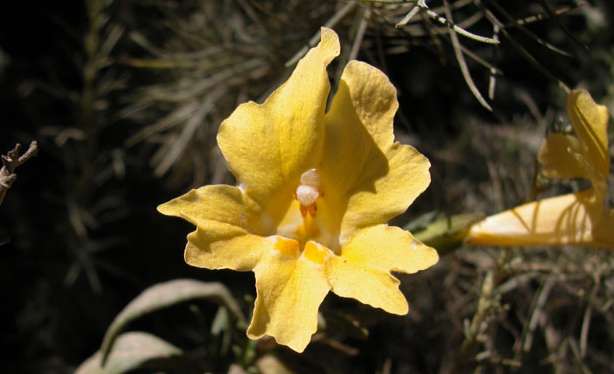
Families with 5 fused petals and superior ovaries
This lesson will cover how to distinguish five families of common plants that have five fused petals and superior ovaries.
This lesson does not cover ALL families with 5 fused petals and superior ovaries. You will encounter at least one more in future lessons.
The families we will cover here are:
The first three have radially symmetrical flowers. Among those:
Plants in the Boraginaceae bear their flowers in coiled cymes.
Plants in the Malvaceae have their filaments fused into a tube around the style.
Plants in the Solanaceae have somewhat varied flower shapes, but they don't have coiled cymes or filaments fused into a tube around the style.
The last three have bilaterally symetrical flowers. Among those:
Plants in the Lamiaceae have deeply lobed ovaries. Those lobes disperse separately at maturity as single-seeded nutlets.
Plants in the Phrymaceae have unlobed ovaries that become capsules and stigma lobes that are flat and close when touched.
Plants in the Plantaginaceae have unlobed ovaries that become capsules (like the Phrymaceae), but they do not have the touch-sensitive stigma lobes.
Members of the Boraginaceae have radially symmetrical flowers arranged in coiled cymes. Sometimes the coils are obvious.

Sometimes the coils are so tight that it is difficult to see that branches of the inflorescence are coiled.

Sometimes the coil is so loose that you have to look closely to notice that the youngest flower bud(s) are tucked up under (or coiled under) the older flowers.

The ovaries may be deeply lobed, forming nutlets at maturity, or not, deeply lobed, usually forming a capsule at maturity. Plant with unlobed ovaries have, at times, been placed in their own family (Hydrophyllaceae). They are now all considered part of Boraginaceae.
Check your understanding:
The flowers themselves have five stamens that are epipetalous (that is, they are fused to the petals).
Some species may have corolla appendages or calyx appendages.

Check your understanding:

The Malvaceae is the hibiscus family.
Check your understanding:
Plants in the Solanaceae are somewhat variable. Their corollas of 5 fused petals can be rotate, campanulate, funnelform, salverform, or cylindric. Their fruits can be berries or capsules.
For simplicity, the only flower type you will be asked to recognize in this class, is the type exhibited by potatoes, tomatoes, and nightshades. It has a rotate corolla with stamens that point straight forward. The sinuses between corolla lobes may be shallow, or they may be so deep that you need to look closely to see that the petals are actually fused at the base:

The Lamiaceae contains many fragrant plants (mints, sages, and many of our other culinary herbs). Its corolla of 5 fused petals is bilaterally symmetrical, generally forming two lips. This family has been called the Labiatae in the past, in reference to those two lips (labia).
There are other families with bilaterally symmetrical corollas of 5 fused petals, but plants of the Lamiaceae have...
(Caution: although members of the Lamiaceae always have opposite leaves, other similar families may also have opposite leaves.)

Check your understanding further:
The Phrymaceae also has a bilaterally symetrical corolla of 5 fused petals (like both the Lamiaceae and the Plantaginaceae), but it has stigma lobes that are flat and sensitive to touch.

These flat stigma lobes close when they are touched, presumably reducing the likelihood of self-pollination.
This phenomenon was featured in one of your first lessons ("Plant Basics"). If you would like to see it again, visit the YouTube video at https://www.youtube.com/watch?v=O2RPIMoz7Mg.
The Plantaginaceae includes most (not all) of the remaining plants with bilaterally symmetrical corollas of 5 fused petals. They do not have deeply lobed ovaries that form nutlets and they do not have touch-sensitive stigmas.
Check your understanding:
Some common members of the Plantaginaceae are in the genus, Penstemon. Presumably, this name refers to the fifth stamen, which is a staminode. In some species, this staminode is glabrous, but in some, it is quite hairy and many species of this genus have common name "beardtongue".

Test your knowledge:
